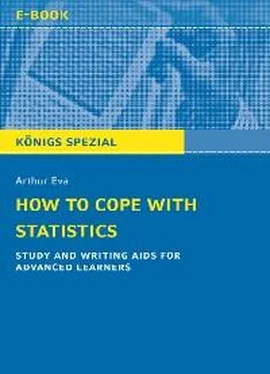KÖNIGS SPEZIAL
Arthur Eva
HOW TO COPE WITH STATISTICS
STUDY AND WRITING AIDS FOR ADVANCED LEARNERS

Über den Autor dieser Publikation:→ Arthur Eva, Jahrgang 1942, Oberstudienrat i. R. → Studium: Anglistik und Geographie, Examen 1967, Universität Mainz → Schuljahr 1963/64 Assistant Teacher, Manor Park School Nuneaton, GB → 1965/66 Teaching Fellow, University of Michigan, Ann Arbor, USA → Fachgruppenleiter Englisch am Oldenburg-Kolleg bis zur Pensionierung (2004) → Zurzeit bei Bedarf ehrenamtlicher Mitarbeiter an der Freien Waldorfschule Oldenburg
Das Werk und seine Teile sind urheberrechtlich geschützt. Jede Verwertung in anderen als den gesetzlich zugelassenen Fällen bedarf der vorherigen schriftlichen Einwilligung des Verlages. Hinweis zu § 52 a UrhG: Die öffentliche Zugänglichmachung eines für den Unterrichtsgebrauch an Schulen bestimmten Werkes ist stets nur mit Einwilligung des Berechtigten zulässig.
1. Auflage 2013
ISBN 978-3-8044-1899-8
© 2013 by C. Bange Verlag, 96142 Hollfeld
Alle Rechte vorbehalten!
Hinweise zur Bedienung
InhaltsverzeichnisDas Inhaltsverzeichnis ist vollständig mit dem Inhalt dieses Buches verknüpft. Tippen Sie auf einen Eintrag und Sie gelangen zum entsprechenden Inhalt.
FußnotenFußnoten sind im Text in eckigen Klammern mit fortlaufender Nummerierung angegeben. Tippen Sie auf eine Fußnote und Sie gelangen zum entsprechenden Fußnotentext. Tippen Sie im aufgerufenen Fußnotentext auf die Ziffer zu Beginn der Zeile, und Sie gelangen wieder zum Ursprung. Sie können auch die Rücksprungfunktion Ihres ePub-Readers verwenden (sofern verfügbar).
Verknüpfungen zu Textstellen innerhalb des Textes (Querverweise)Querverweise, z. B. „s. S. 26 f.“, können durch Tippen auf den Verweis aufgerufen werden. Verwenden Sie die „Zurück“-Funktion Ihres ePub-Readers, um wieder zum Ursprung des Querverweises zu gelangen.
Verknüpfungen zu Inhalten aus dem InternetVerknüpfungen zu Inhalten aus dem Internet werden durch eine Webadresse gekennzeichnet, z.B. www.wikipedia.de. Tippen Sie auf die Webadresse und Sie werden direkt zu der Internetseite geführt. Dazu wird in den Web-Browser Ihres ePub-Readers gewechselt – sofern Ihr ePub-Reader eine Verbindung zum Internet unterstützt und über einen Web-Browser verfügt. Hinweis:Bitte beachten Sie, dass Webadressen nach Erscheinen dieses ePubs gegebenenfalls nicht mehr aufrufbar sind!
INHALT
1. PRELIMINARIES
2. DATA, NUMBERS, FIGURES
3. BASICS: TABLES AND DIAGRAMS – AN OVERVIEW
4. VOCABULARY BUILDING – GETTING USED TO ESSENTIAL TECHNICAL TERMS
5. NORMING – REQUIREMENTS, APPROACHES, USER TIPS
6. PERFORMING – ANTICIPATION AND SIMULATION OF FORESEEABLE STANDARD SITUATIONS
7. EPILOGUE
REFERENCES AND ACKNOWLEDGEMENTS
When you deal with statistics, you will primarily have to cope with numbers, figures, data, tables, and visual aids in the form of diagrams.
It might be a good idea to thumb your way through this compact course in elementary statisticswithin a few minutes before you have a closer look at those items that interest you most. Browsing through unit after unit, looking at this and that for orientation or out of curiosity, you will get a rough idea of what this user manual can do for you and of what lies ahead of you. Moreover, as a by-product, so to speak, you will automatically and effortlessly pick up and remember several essential statistical termsas you go along. They appear in boldthroughout this booklet. Memorize these high frequency topical termsand recycle them in the new context of your exercise and examination papers whenever it is possible and adequate to do so. A good command of the technical termsoften used by analysts and other experts is essential for a good performance. And recycling useful high frequency expressions works wonders. Just give it a try!
| 2. |
DATA, NUMBERS, FIGURES |
Dataare factsand figuresfrom which conclusionsmay be drawn. They may also have an illustrative function. The topical term´ data´ is commonly used with a plural verb, for example in a statement like, “ These data show/ suggest/ indicate/ provethat binge drinking is on the increase in Sampleland.” But its use with a singular verb is also widespread, for instance in such a statement as, “ This data [=this set of data] refers tothe situation in Sampleland in 2011.”
The terms “number”and “figure”are near-synonyms. In some contexts they are interchangeable, in others they are not. Take the statement, “A large numberof people (42, perhaps) have applied for the job.” The number of people is countable, and in this context saying “… a large figure/ dataof people” would be wrong.
In the following example, you could use number, figure, or data: “The latest official numbers/figures/data revealthat Sampleland´s economy has expanded by 2.1% in 2011, compared to 1.7% in 2010.” The three terms are equally acceptable here.
| 3. |
BASICS: TABLES AND DIAGRAMS – AN OVERVIEW |
Конец ознакомительного фрагмента.
Текст предоставлен ООО «ЛитРес».
Прочитайте эту книгу целиком, купив полную легальную версию на ЛитРес.
Безопасно оплатить книгу можно банковской картой Visa, MasterCard, Maestro, со счета мобильного телефона, с платежного терминала, в салоне МТС или Связной, через PayPal, WebMoney, Яндекс.Деньги, QIWI Кошелек, бонусными картами или другим удобным Вам способом.













